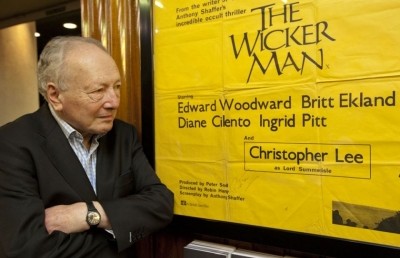Fantasia: Turning the Rear View Mirror
Ten Years and Counting at Concordia

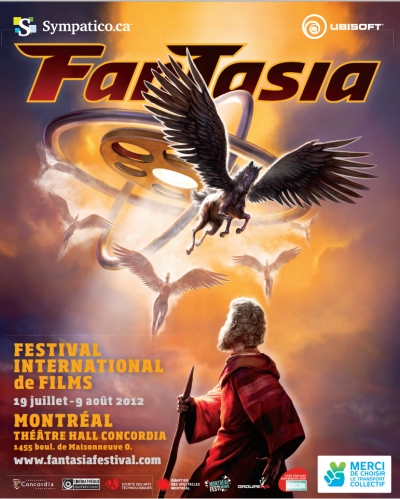
2012 marks the tenth anniversary of Fantasia’s association with Concordia University that began after the dreaded Imperial meltdown of 2002 that left fans without their festival for one dreary summer. I remember it well; I had only begun covering the festival for Offscreen in 2001 and felt like the rug had been pulled out from under me. And although 2002 ended up being my most prolific year of festival coverage on record (with lengthy reports on Mutek, Comedia and Festival Nouveau Cinema), it just wasn’t the same without Fantasia. But what seemed at the time like a potential eternity without our favourite festival has turned into a mere blip on the memory’s radar, one that prompted the move to Concordia’s facilities – a move that has proven itself wise many times over. And with the 2002 gap, the 2011 edition of Fantasia marked my tenth year covering the festival for Offscreen. And so as we prepare for the imminent launch of the 2012 edition it seems appropriate to reflect for a moment on the past decade of the festival and where it has brought us today.
At the top of my very first report back in 2001, I mused that the festival experience is “rhizomatic,” invoking Deleuze and Guattari’s famous reference to the root structure as model for thinking through the notion of networked environments. I wrote, “When I see a large number of films in quick succession, not only do they blur together, but I become less interested in each individual film as a holistic work, instead drawing moments from each that affect me and relate them to similar moments found in other films,” a pattern I identified with the notion of the “plateau” as the essence of a non-hierarchical approach to organizing information that allows jumps from one region to another without need for a linear path. That was back when I was a fledgling MA student in Concordia’s Film Studies program, a time when I held out strong hope that I might prove intellectually gifted enough to engage with the works of Deleuze and Guattari on the level required to properly make sense of their contributions to the field. Ten years on I now know better. Over the past decade I finished the MA, and a PhD, saw the births of my two children, lost two of three cats and then gained two more (the third drawing the line through it all, now 17 years old – one year up on Fantasia!). The younger me was overwhelmed with the abundance offered by film festivals and how to make sense of them in a report. I was ever in search of ways to compensate for, and make use of, the replacement of single-film immersion with the gathering and collating of multitudinous fragments. However, I am now inclined to see my Fantasia experience as more of a track hewn through the networks of my life, a series of points that, with enough distance, turn into a straight line revealing consistency and stability where once there had been only incredible volatility. And I now leave Deleuze and Guattari alone.
Most gratifying has been to watch the festival, and its regular contributors, age with grace. Fantasia has gone from upstart cult festival to an internationally renowned showcase for cinemas of the fantastic, with an increasing industrial presence each year making it a destination marketplace festival as well as a display for great genre filmmaking. Yet amazingly, I have detected little change in the spirit of the festival. Somehow, despite increasing corporate sponsorship (providing much needed funds to make the festival run), Fantasia still feels like a cult affair, its raging fans still coming out in force, the programming remaining true to its origins. There is a remarkably clear understanding of mandate amongst the festival organizers that has put them in a good position to attract people to their cause rather than submit to hostile take-over. This gives me hope for the productivity of the newly minted “Memorandum of Understanding” signed last month between Concordia and Fantasia with the intent of creating official patterns of integration between these organizations. And I am pleased to have been a part of one of the initial undertakings of this newly official relationship as jury member for this year’s “When Concordia Meets Fantasia” program featuring the best in cinema of the fantastic from Concordia students over the past several years. And this is just one of many initiatives planned to bring the Concordia community into Fantasia’s sphere, and vice-versa. Hopefully such integration will grow without eroding Fantasia’s core.
As we have watched Fantasia grow up without losing the spirit of its childhood, we have also watched directors, studios, nations, and transnational networks develop as their works are traced in the annals of the festival programming. And so I will look forward to this year’s festival by way of looking back, a brief perusal of what I’m most looking excited about this year as informed by what I have most appreciated in the past.

For Love’s Sake
For me, Fantasia has been defined by the work of Takashi Miike. Although I was exposed to some of Miike’s earlier work at the Vancouver International Film Festival (including his first theatrical feature Shinjuku Triad Society, and the beautiful Bird People in China), my first years of attending Fantasia brought major breakthrough films like Dead or Alive, Audition, Dead or Alive 2: The Birds, and Visitor Q, charging these earlier festival years with an energy that wrote the Fantasia experience on Miike’s terms (see my 2001 coverage here and here).
For whatever reason, Miike’s best work screened at Fantasia before the shift to Concordia’s grounds in 2003. While that first year at the new venue brought four Miike films, including the much-loved Ichii the Killer, less excessive and/or eccentric work like Man in White and Graveyard of Honor was also on display and fans began to get a sense that Miike might not always meet expectations set up by the Fantasia environment (see 2003 Miike coverage here). In 2004 Deadly Outlaw Rekka caused something of a stir as a bit of a tease, pushing the limit of restraint as far as it could go while still delivering something akin to the catharsis offered by his millennial work (see 2004 coverage here). But with his increasing success, both in Japan and Internationally (thanks to festivals like Fantasia), he has been taking on more big studio projects like One Missed Call that have, more often than not, left me unmoved. Odd outings like The Great Yokai War, Gozu and Izo gave me flashbacks to earlier days, but it wasn’t until Big Bang Love in 2007 that my hope for a renewal of my early exhilaration returned. Sadly, that film’s avant-garde theatricality has proven a one-off for Miike, and later outings like Sukiyaki Western Django and 13 Assassins have, to my palette, been stripped of all but a few hints of the signatures that marked his breakthrough work. The blurbists tend to play up the auteurist angle when writing about Miike, suggesting that his personal flair is always in evidence across his genre-hopping leaps between independent and studio work. But I think there’s a strong case to be made for Miike as a kind of anti-auteur, an “agitator” (to borrow Tom Mes’ appropriation of a Miike film title for his book on the director) who provokes by way of frustrating expectation at every turn. But this frustration of expectation gives every Miike screening a special flair; in the end, you really never know what you’re going to get with him, a situation bound to keep you on the edge of your seat regardless of how the films turn out. And so, as usual, it is with great anticipation that I await the official opening film of this year’s festival, For Love’s Sake, along with Ace Attorney, Miike’s two entries for Fantasia 2012.
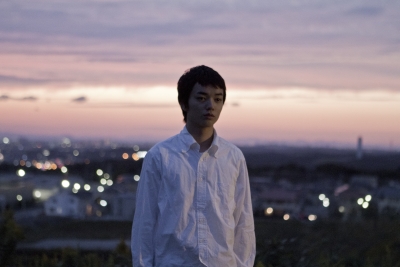
Isn’t Anyone Alive?
A filmmaker who has much more consistently lived up to expectation for me despite his own radically shifting style is Sogo Ishii, and this year’s festival will see the first Fantasia screening of an Ishii film since the shift to Concordia (though under his new given name of Gakuryu). Ishii has easily been one of the most significant if little known filmmakers on the Japanese scene since he began his 8mm punk filmmaking in the 1970s, and since then he has moved through absurdist comedy to psychedelic thrillers before merging all these together for his post-2000 work (for a good account of his work over the years see Midnight Eye). In 2001, Fantasia was blessed with a screening of Gojoe that, although in an abridged export version, still proved one of the highlights of that year. A metaphysical samurai film, it has just the right mix of the grounded and the fantastic with a taste of the cyberpunk aesthetic that Ishii helped create to make it a truly unique entry in the jideki genre. I’ve never quite understood why other of his films haven’t played Fantasia. I saw Electric Dragon 80,000 V and Dead End Run at Festival Nouveau Cinéma in 2001 and 2002 respectively. With stories about an electrified lizard hunter, a cell-phone tapping Buddha, and a dancing corpse trying to make peace with the man responsible for her death, it seems to me that they would have been much better received at Fantasia than FNC. And this was before Fantasia programmer Julien Fonfrède jumped ship to FNC to run the “Temps Zero” program that now brings a hearty taste of Fantasia flavour to the chilly days of mid-October each year. Indeed, there has been some cross-over between the festivals, as when long-time Fantasia favourite Kiyoshi Kurosawa’s latest film Tokyo Sonata played there instead of Fantasia, justified by a fairly dramatic turn away from the fantastic themes of Cure, Séance and Doppelganger to a sharper focus on the domestic tensions that underlie each of those films in their own ways (see my coverage of the film here). Of course there could also be industrial factors at play in the decisions to screen at one festival instead of another. Regardless, Ishii’s work has been consistently Fantasia-ready, shall we say, so it’s very exciting for me that this year’s audience will get a taste of his work in Isn’t Anyone Alive? And after the titular question is answered, perhaps we’ll also know whether or not Ishii’s change of given name to Gakuryu has any bearing on his cinematic style.
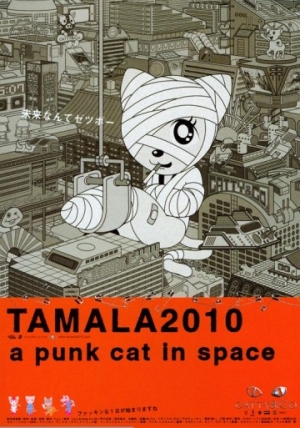
Tamala
Of course I’ll never forget Fantasia’s first year at Concordia, for this was the year of Tamala 2010: A Punk Cat in Space, quite possibly my all-time favourite Fantasia film. I wrote about it extensively in my report for that year, marveling at its unusual animation styles while drawing lofty connections between Thomas Pynchon’s Gravity’s Rainbow and Tamala’s adventures as the unwitting pawn of an interplanetary corporate branding conspiracy. And the film seems all the more significant today as increasing interest is being paid to “media convergence,” or the “media mix” as it’s known in Japan: a strategy for cross-media promotion of characters and the like to maximize market penetration and shape patterns of both production and consumption (as Marc Steinberg charts in his new book Animé’s Media Mix). This goes beyond the ubiquitous practice of turning comics into films or films into video games. The media mix revolves around designing figures like Hello Kitty as cultural phenomena, a cross-media brand to which Tamala’s character design overtly nods. And for me, the film prompted both reflection upon the craziness of the branding complex in late capitalist society while also instilling in me a profound desire to ravage the merchandise table that was set up after the screening, from which I purchased one of only five DVD copies of the film, a Tamala keychain, and a soundtrack CD that included an action figure (which is still sitting next to my computer monitor). I was dying for more of their goodies but simply didn’t have the cash. It was said that the film was supposed to be the first of a trilogy, but to date only a strange little DVD of Tamala shorts has appeared as a follow-up. Maybe next year? I’ll start saving up.
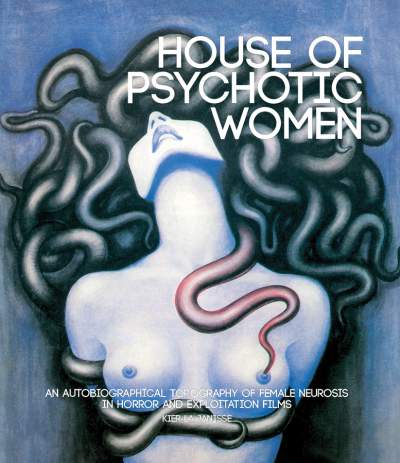
[Kier-La’s book pic: http://cdn.bloody-disgusting.com/wp-content/uploads/2012/07/FAB130.jpeg]
House of Psychotic Women
And of course the merchandising experience is always an important part of Fantasia. While the festival itself has only T-shirts and posters to sell, there are also invited merchants who have a role to play in fleshing the festival out and opening it up beyond the boundaries of the screening rooms. Top of the list is the FAB Press table featuring their excellent catalogue of books on cult films. They published the aforementioned Tom Mes book on Takashi Miike, Agitator, along with his follow-up book on Shinya Tsukamoto, Iron Man, two of my favourite Fantasia merchandise purchases over the years along with Jasper Sharp’s Behind the Pink Curtain on Japanese porn and Mark Schilling’s No Borders, No Limits on Nikkatsu Action Cinema. In a certain spirit of media convergence, many of these FAB releases have been integrated into the festival through related screenings, like the pink film series in 2009 and the Nikkatsu mini-retrospective in 2007 that returns this year in expanded form. Also exciting this year is the launch of Kier-La Janisse’s much anticipated book House of Psychotic Women to be accompanied by screenings of four of the films under discussion therein: Full Circle [aka The Haunting of Julia], Possession, Christiane F., and Jekyll et les femmes. Also notable are the good people at Synapse Films who have been releasing cult material in special DVD editions with very high standards of quality, and who made my decade in 2006 when they put out the Small Gauge Trauma (reviewed here) compilation of the best of Fantasia short films from the festival’s first few years. The disc includes Dennison Ramalho’s Love from Mother Only, my other all-time favourite film to have scorched the big screen in Concordia’s Hall Theatre. And this year it won’t just be we consumers buying products that tie-in with festival programming: 2012 marks the first edition of the Fantasia Industry Rendez-Vous to include new initiatives like the Fantasia Film Market to put filmmakers in touch with distributors, and the Frontières International Co-Production Market to foster intercontinental co-production of genre films. With initiatives like these, Fantasia steps out of shadows to become a serious player on the international film festival circuit, drawing on the energy of its first 16 years and pushing that into new territory so that it might be returned in kind.

Inglourious Basterds
One of the key signs that Fantasia is garnering greater industrial attention is the increasingly high profile opening and closing screenings it is attracting. 2010’s premiere of Disney’s Sorcerer’s Apprentice was a case in point. But much more significant was the surprise coup of Inglourious Basterds as the closing film for 2009. I have written extensively about the Fantasia/Tarantino connection in my previous Fantasia coverage. Kill Bill Vol. 1 was in the theatres during Fantasia 2007, and fittingly so. More than any of his previous films, Kill Bill engages with exactly the type of genre work that fuels Fantasia, and it does so by paying loving homage to this work. As I wrote in my 2003 report,
“In a way, Kill Bill could be understood as a film festival all in itself, and is most certainly tailor-made for the Fantasia crowd… Fantasia offers an environment in which the audience is engaged with the programming at a much higher level [than general festivals], and speaks to them in a language that continues for these fans year round. It’s like the summit of a secret society of film geeks… Fantasia is the lodge where this society’s yearly proceedings go down and we all understand once again why the cinema of the fantastic is one realm where the joy of cinematic experimentation is far higher than average. And this is why it is possible to sit through a lot of questionable films with great enjoyment, for at least there is a spirit of playfulness with the medium that is absent from other genres. Can you imagine a festival of romantic drama films? How long would we last through a series of average entries in this category? Not very…”
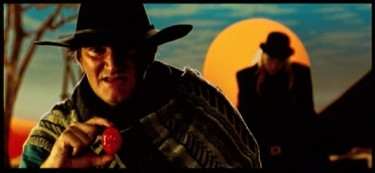
Sukiyaki Western Django
So in 2008, when Tarantino had a cameo in Takashi Miike’s Sukiyaki Western Django, things started to come full circle. Although I didn’t love the film, Tarantino’s presence in Miike’s film speaks volumes to the spirit of this festival. In perhaps my favourite passage from any of my past Fantasia reports, I wrote,
Here we find Quentin Tarantino opening the film on a superbly cheesy desert set, featuring a deliberately cardboard Mt. Fuji backdrop flanked by a big orange sun hanging on a string. Tarantino acts as the film’s narrator, of sorts, introducing the back-story before the film sets off in a more realist manner. Later in the film we find Tarantino again, now an old man inserted as a character within the narrative proper. At one point he announces that he has always been a die-hard otaku at heart, causing an uproar of enthusiastic screaming and applause from the packed audience to rival any Fantasia response I’ve experienced to date. This moment was the perfect embodiment of the Fantasia experience. A line of empathy opens up between Tarantino and the audience as he is positioned as a fan-boy living out his dream of being in one of his idol’s films, just as many in the audience might dream of being in a Tarantino film. And so Tarantino becomes a member of the Fantasia audience, enabling a kind of transmogrification that can be read through Tarantino’s own films as he increasingly defines his work around practices of fandom through his cinematic homages to all the genres and styles that have influenced him over the years. And this street seems to go two ways, with Miike himself demonstrating his own love of Tarantino by embedding him within his latest outing, itself an homage to the Western genre that so fascinated Tarantino in Kill Bill Vol. 2. This moment acts as the nexus point of a kind of incestuous vicious circle in which the line between creation and influence is almost completely dissolved, and Tarantino’s otaku line invites the audience over the threshold to take part in the orgy. I’m surprised the whole room didn’t implode leaving a black hole in its wake to suck any remaining onlookers into its crushing vortex. Maybe then the administration would finally have to change the horrible seats in the Hall Theatre.
And although we don’t have any direct Tarantino presence this year, Fantasia’s tradition of showcasing classic Shaw Brothers titles on 35mm – a major influence on Kill Bill (which opens with the appropriated SB logo) – continues with a presentation of the only surviving print of Fists of the White Lotus. The film stars Gordon Liu as Shaolin disciple Hung who, in the opening sequence, vanquishes regular screen adversary Pai Mei, here played by Wilson Tong, elsewhere interpreted by director Lo Lieh (who plays Pai Mei’s brother here), and of course most recently re-incarted by Gordon Liu himself in Tarantino’s Kill Bill vol. 2.
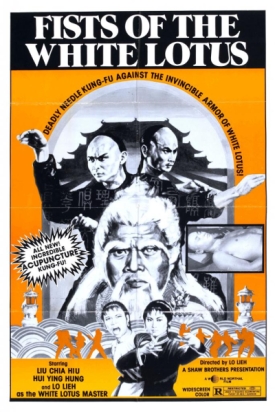
Fists of the White Lotus
But perhaps the most telling sign that Fantasia is growing up is the appearance last year of the “My First Fantasia” series, free for kids and their parents. With my oldest daughter having just turned three last week she was a bit young last summer to try it out (though we did successfully make it through a screening at the “Wee Wolves” series at FNC). So I am pleased to see the return of the series this year with two short film programs, the retro Japanese gem Les Aventures de Chatran (in a rare French version apparently more faithful to the original Japanese than the English dub), and the Canadian première of the animated Zarafa about an escaped African slave boy’s adventures in the times of intercontinental colonialism. Perhaps Zarafa will serve, along with Sukiyaki Western Django, as a useful primer for Tarantino’s Django Unchained, coming Christmas Day to a theatre near you… We’ll leave the kids at home for that one.
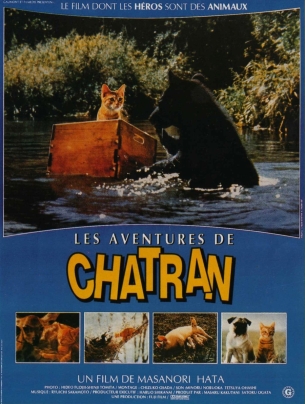
Les Aventures de Chatran
Please visit the Fantasia website for all kinds of good stuff, trailers, video interviews, online catalogue, Spectacular Optical, and much more, updated daily!






